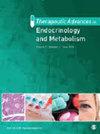Calcitonin: current concepts and differential diagnosis
IF 3.9
3区 医学
Q2 ENDOCRINOLOGY & METABOLISM
Therapeutic Advances in Endocrinology and Metabolism
Pub Date : 2022-01-01
DOI:10.1177/20420188221099344
引用次数: 7
Abstract
Calcitonin (CT) is most effectively produced by the parafollicular cells of the thyroid gland. It acts through the calcitonin receptor (CTR), a seven-transmembrane class II G-protein-coupled receptor linked to multiple signal transduction pathways with its main secretagogues being calcium and gastrin. It is clinically used mostly in the diagnosis and follow-up of medullary thyroid carcinoma (MTC). Hypercalcitoninemia can be attributed to primary (e.g. CT-secreting tumor) or secondary (e.g. due to hypercalcemia) overproduction, underexcretion (e.g. renal insufficiency), drug reaction (e.g. β-blockers), or false-positive results. In clinical practice, elevated basal calcitonin (bCT) is indicative, but not pathognomonic, of MTC. Current literature leans toward an age as well as gender-specific cutoff approach. bCT >100 pg/ml has up to 100% positive prognostic value (PPV) for MTC, whereas bCT between 8 and 100 pg/ml for adult males and 6 and 80 pg/ml for adult females should be possibly further investigated with stimulation calcitonin (sCT) tests. Calcium is showing similar efficacy with pentagastrin (Pg) sCT; however, the real value of these provocative tests has been disputed given the availability of new, highly sensitive CT immunoassays. Anyhow, evidence concludes that sCT <2 times bCT may not be suggestive of MTC, in which case, thyroid in addition to whole body workup based on clinical evaluation is further warranted. Moreover, measurement of basal and stimulated procalcitonin has been proposed as an emerging concept in this clinical scenario. Measuring bCT levels in patients with thyroid nodules as a screening tool for MTC remains another controversial topic. It has been well established, though, that bCT levels raise the sensitivity of FNAB (Fine Needle Aspiration Biopsy) and correlate with disease progression both pre- and postoperatively in this situation. There have been numerous reports about extrathyroidal neoplasms that express CT. Pancreatic, laryngeal, and lung neuroendocrine neoplasms (NENs) are most frequently associated with hypercalcitoninemia, but CT production has also been described in various other neoplasms such as duodenal, esophageal, cutaneous, and paranasal NENs as well as prostate, colon, breast, and lung non-NENs. This review outlines the current biosynthetic and physiology concepts about CT and presents up-to-date information regarding the differential diagnosis of its elevation in various clinical situations.降钙素:目前的概念和鉴别诊断
降钙素(CT)最有效地由甲状腺的滤泡旁细胞产生。它通过降钙素受体(CTR)发挥作用,这是一种七跨膜II类G蛋白偶联受体,与多种信号转导途径相连,其主要促分泌因子是钙和胃泌素。它在临床上主要用于甲状腺髓样癌(MTC)的诊断和随访。高降钙素血症可归因于原发性(如分泌CT的肿瘤)或继发性(如由于高钙血症)生产过剩、兴奋不足(如肾功能不全)、药物反应(如β-阻滞剂)或假阳性结果。在临床实践中,基础降钙素(bCT)升高是MTC的指标,但不是病理标志。目前的文献倾向于一种年龄和性别特定的截止方法。bCT>100 pg/ml对MTC具有高达100%的阳性预后价值(PPV),而bCT在8至100之间 成年男性和6岁及80岁的pg/ml 成年女性的pg/ml应通过刺激降钙素(sCT)测试进行进一步研究。钙显示出与五肽胃泌素(Pg)sCT相似的疗效;然而,鉴于新的高灵敏度CT免疫测定的可用性,这些挑衅性测试的真正价值一直存在争议。无论如何,有证据表明sCT<2倍bCT可能不提示MTC,在这种情况下,除了基于临床评估的全身检查外,甲状腺检查也是有必要的。此外,在这种临床情况下,基础和刺激降钙素原的测量已被提出为一个新兴概念。测量甲状腺结节患者的bCT水平作为MTC的筛查工具仍然是另一个有争议的话题。然而,在这种情况下,bCT水平提高了FNAB(细针抽吸活检)的敏感性,并与术前和术后的疾病进展相关。关于表达CT的甲状腺外肿瘤,已有许多报道。胰腺、喉和肺神经内分泌肿瘤(NENs)最常与高降钙素血症相关,但CT产生也被描述为各种其他肿瘤,如十二指肠、食道、皮肤和鼻旁NENs,以及前列腺、结肠、乳腺和肺非NENs。这篇综述概述了当前关于CT的生物合成和生理学概念,并介绍了在各种临床情况下CT升高的鉴别诊断的最新信息。
本文章由计算机程序翻译,如有差异,请以英文原文为准。
求助全文
约1分钟内获得全文
求助全文
来源期刊

Therapeutic Advances in Endocrinology and Metabolism
Medicine-Endocrinology, Diabetes and Metabolism
CiteScore
7.70
自引率
2.60%
发文量
42
审稿时长
8 weeks
期刊介绍:
Therapeutic Advances in Endocrinology and Metabolism delivers the highest quality peer-reviewed articles, reviews, and scholarly comment on pioneering efforts and innovative studies across all areas of endocrinology and metabolism.
 求助内容:
求助内容: 应助结果提醒方式:
应助结果提醒方式:


